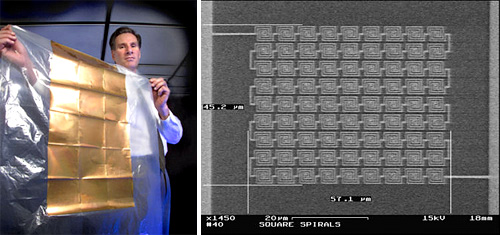
By Andrew Liszewski
Current commercial grade solar panels are only able to transform about 20% of the usable energy that strikes them into electricity. And while the most complicated and expensive panels are a bit better, operating at about 40% efficiency, there’s obviously room for improvement. So researchers at the Idaho National Laboratory working with Microcontinuum Inc. and the University of Missouri are hoping a new type of solar panel made with nanoantennas could be the next breakthrough.
The new approach, which garnered two 2007 Nano50 awards, uses a special manufacturing process to stamp tiny square spirals of conducting metal onto a sheet of plastic. Each interlocking spiral “nanoantenna” is as wide as 1/25 the diameter of a human hair.
Because of their size, the nanoantennas absorb energy in the infrared part of the spectrum, just outside the range of what is visible to the eye. The sun radiates a lot of infrared energy, some of which is soaked up by the earth and later released as radiation for hours after sunset. Nanoantennas can take in energy from both sunlight and the earth’s heat, with higher efficiency than conventional solar cells.
The researchers predict that each nanoantenna could absorb close to 80% of the available energy, but there’s still research needed to perfect the design. While they can simulate how one nanoantenna will perform, things get a bit different when you cram about 10 million of them into a 6-inch circle. But the possibility of having a highly-efficient solar panel that’s as thin and flexible as plastic wrap, and as cheap as inexpensive carpet is very encouraging.
[ Harvesting the sun’s energy with antennas ] VIA [ EcoGeek ]




